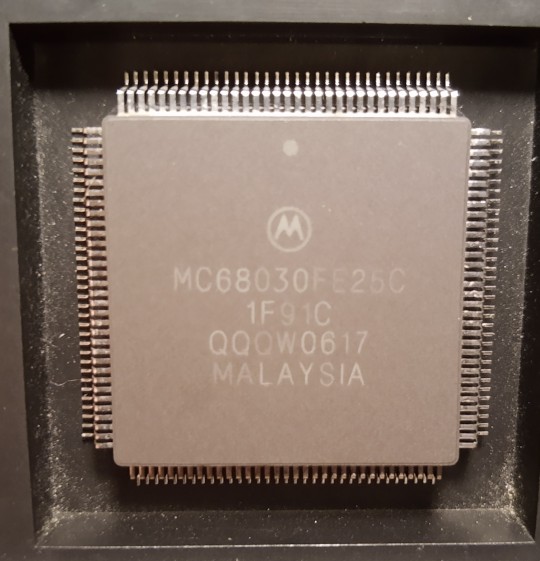#Motorola 68030
Text
More Speed, More Power, Pretty Pictures
I added some crude functions to the ROM monitor on my Wrap030 project to read the root directory of a FAT16-fomatted disk and load binary files into memory to execute. This opens up a new option for developing programs and running them on the computer, and makes it easier to keep programs on-hand for loading when I demonstrate the computer.
So what new program do I build first for running from disk? The same Mandelbrot renderer I've been using all along, of course! All I needed to do to get it running from disk was adjust a few load instructions to use PC-relative addressing and then change the vasm output to raw binary.
It ran without issue ... mostly. I had been noticing some instability with the system in general. It's not really related to the programming work I've been doing, it just tended to show itself more when doing the kind of FPU-intensive processing required for the Mandelbrot program. Sometimes the system wouldn't boot at all, sometimes it would continually reset. Other times it would run fine for a while, but randomly throw a coprocessor protocol exception (especially when using double- or extended-precision floating point values).
I had a pretty good idea of where this instability was coming from ...
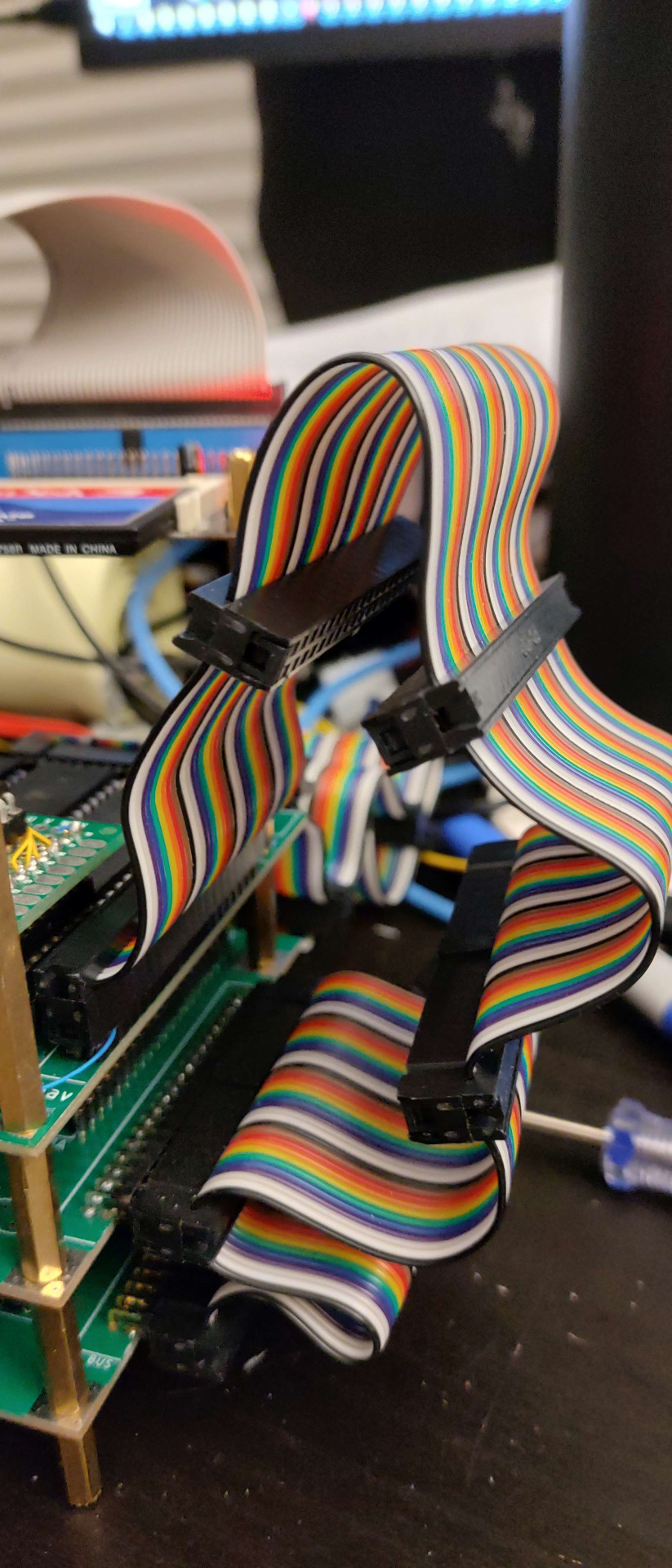
As someone on Discord put it, that's a pretty little antenna I've got there.
High speed computers don't like excessively-long wiring between components. I made the ribbon cables long because there were other boards I developed for this system. But, I'm only using the CPU board, the FPU + IDE mezzanine board, and the video generator board. All that extra wire is just making things more difficult.
A year ago, when I first put these three boards together, I had to bump the bus speed down to 25MHz to get it to run. I could run the CPU board up to 56MHz by itself, and I could get it to run with one expansion board or the other up to 40MHz, but with all three boards, 25MHz was the best I could do (out of the oscillators I had on hand). I have some 33MHz oscillators now, and while I could get it to run sometimes, it was obviously far more unstable.
It was time to trim those pretty little antennas.
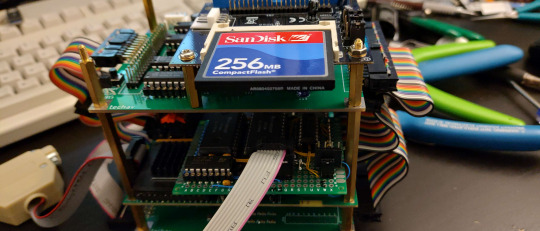
I left room for one more card, in case I can get my DRAM card working later, but trimmed a few inches off. The result? Rock solid at 25MHz now.
... and at 32MHz.
... but 40MHz still doesn't run.
I am quite pleased with that result. My target for this system in the beginning was 25MHz. That extra 30% speed increase is very noticeable, especially when running a program like the Mandelbrot renderer.
But I had a thought.
My FPU is rated for 25MHz, and here it's running solid at 32MHz along with the rest of the system. But my FPU board was designed to support the FPU running at a separate clock speed from the rest of the system (the 68881/68882 FPU is actually designed to support this, so I implemented it when I built my mezzanine board).
What would happen if I tried running the FPU even faster? Perhaps using that 40MHz oscillator that I couldn't use for the complete system?
Surprisingly, not a problem running the CPU at 32MHz and the FPU at 40MHz.
... or 50MHz
... or 55MHz
... or 67MHz!
Once again, I've run out of faster oscillators. This computer is running stable with its FPU clocked at over two and a half times its rated speed.
The video above is a real-time capture of the VGA output of this machine running that Mandelbrot renderer (now modified to use 96-bit extended-precision floating-point arithmetic!) with the CPU & main bus clocked at 32MHz and the FPU clocked at 67MHz. Some frames take minutes to render. Some complete in as little as seven seconds.
I am in awe. While I had big dreams when I first started working on this project six years ago, I never could have imagined it running this well at that kind of speed. I am very happy with how this project has turned out so far, and can't quite believe I actually built something like this.
I typically wrap up these posts with a plan of where to take the project next, but the project has already exceeded my expectations. There is so much it is already capable of now that I have a permanent storage option available. I guess I could try getting that DRAM card running to expand the main memory beyond 2MB, or try adding a keyboard and some text routines to complement the video card. Both are good options towards getting a proper operating system running, which has always been a goal of the project.
Either way, I'm sure I'll have fun with it.

#wrap030#mc68030#homebrew computing#retrocomputing#mandelbrot#motorola 68k#motorola 68030#homebrew computer#assembly programming#motorola 68882
18 notes
·
View notes
Text
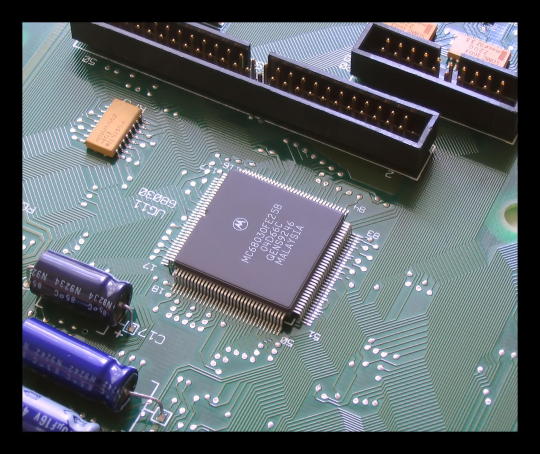
1 note
·
View note
Text
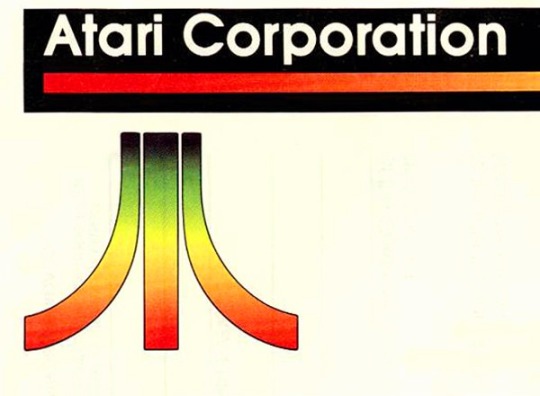






🇺🇲 Dive into the realm of computing nostalgia with a look back at the Atari Corporation's iconic personal computers—the Atari 400/800, Atari 520ST, and Atari Falcon! Introduced by Atari Corporation, a pioneer in the world of gaming and computing, these machines left an indelible mark on the landscape of home computing during their respective eras.
⌨️ The Atari 400 and Atari 800 made their debut in 1979, offering users a glimpse into the future of personal computing. With their sleek design and innovative features, including custom graphics and sound capabilities, these machines quickly gained a dedicated following among early computer enthusiasts.
🚀 Fast forward to 1985, and Atari unleashed the Atari 520ST—a groundbreaking computer that revolutionized the industry with its impressive performance and affordability. Boasting a powerful Motorola 68000 processor and advanced graphical capabilities, the 520ST became a favorite among musicians, artists, and gamers alike, earning a reputation as a versatile and reliable machine.
💻 In 1992, Atari continued its legacy of innovation with the introduction of the Atari Falcon—a high-performance computer designed for the next generation of computing enthusiasts. Featuring a Motorola 68030 processor, enhanced graphics and multimedia capabilities, and built-in MIDI support, the Falcon pushed the boundaries of what was possible in home computing at the time.
💾 The Atari 400/800 series was known for its distinctive membrane keyboard and cartridge-based software, while the Atari 520ST gained popularity for its compatibility with industry-standard software and peripherals, earning it a place in the hearts of musicians and creative professionals.
🕹️ Although the Atari Corporation's foray into personal computing was relatively short-lived, the legacy of the Atari 400/800, Atari 520ST, and Atari Falcon lives on in the annals of computing history, inspiring generations of technology enthusiasts and paving the way for future innovations.
#techtime chronicles#old computers#atari#atari corporation#companies#computing#computers#computer#computer stuff#innovation#industry#usa#made in usa#atari 400#atari 800#atari vcs#atari falcon#atari 520ST#computer science#computer accessories#basic#keyboard#hardware#software#motorola#processor#multimedia#graphic#old technology#old tech
11 notes
·
View notes
Note
Im new to Fantasy Computers. If this entire thing is just an Emulator, did you also create your own Instruction Set? Or is it based on a real one.
It's based on the Motorola 68030, so I actually get to target it with plain ol' GCC. Pretty much off-the-shelf. As opposed to, I dunno, writing my own LLVM backend to go with the custom instruction set.
12 notes
·
View notes
Text
2004 imac operating system

2004 IMAC OPERATING SYSTEM FOR MAC
2004 IMAC OPERATING SYSTEM MAC OS X
2004 IMAC OPERATING SYSTEM MANUALS
AppleScript is part of today’s Automator and offers a way to automate operating system and app functions.Ībout this time, Apple started using PowerPC processors in the Mac line. It was a big improvement over earlier versions, offering more stability, virtual memory support, cooperative multitasking through MultiFinder, and the AppleScript scripting language. Of all of the original System releases, I remember System 7 as being the most long-lived. System 6 also brought support for the Motorola 68030 CPU and the 1.44MB SuperDrive floppy. That bootable diskette was a direct ancestor of the Disk Utility we still use today. One of these diskettes, “Disk Utilities 1”, came with Disk First Aid and HD SC Setup.
2004 IMAC OPERATING SYSTEM MANUALS
For $49, users got three manuals and four diskettes. System 5 and 6Īpple began charging for operating system upgrades with System 5. ADB also worked with adapters to connect Macs to AppleTalk networks. It also supported Apple Desktop Bus, used for many years to connect keyboards, mice, and other devices. System 4.1 was notable in that it supported the Motorola 68020 CPU, expansion slots, and color display of the Macintosh II. System 3 brought 800K startup drives, SCSI for connectivity to scanners, printers, and storage, AppleShare (early networking and file sharing). For example, System 2 brought multiple folders and screenshots (Command – Shift – 3), while System 2.1 added support for the Apple Hard Disk 20 (that’s 20MB, not GB…). System 1 through System 4 (1987) offered a few enhancements along the way. Overlapping, resizable windows the Finder, folders, a mouse-controlled pointer, the Trash can, and the top menu bar anchored by the Apple icon. In the two years that the Lisa was on the market, it sold only 10,000 units.Īs crude as the System 1 desktop looks in the screenshot above, it introduced many concepts that still exist in macOS today. Apple had released the Lisa with a GUI in 1983, but it was ridiculously expensive ($9,995, equivalent to almost $26,000 in 2020 dollars), slow, and used unreliable floppy disks coupled with a 5 MB hard disk drive. It was the first popular consumer OS to use a graphical user interface. For those of us who were around at the time the first Mac was released, System 1 was a revolutionary operating system.
2004 IMAC OPERATING SYSTEM MAC OS X
On that day, twenty years ago, Apple introduced the next generation of the Mac operating system – Mac OS X 10.0 “Cheetah.” The introduction was no small matter, as it marked a change in how Macs work that remains up to this day with macOS 11 “Big Sur.” Let’s take a look at the history of Mac operating systems from 1984 until now, starting with the “Classic” operating system introduced in 1984 and ending with Big Sur.Īt the beginning (1984), there was System 1.
2004 IMAC OPERATING SYSTEM FOR MAC
March 24, 2001, was a banner day for Mac users.

0 notes
Photo


I play a lot with my PowerBook 100 these days. It’s a part of a large article about early Macs for my main blog (in Czech). PB100 is a cool office machine and it’s always a pleasure to work with it. I mostly run a text editor and a terminal emulator (the 9600 baud connection to a Linux box that can be used for the Internet access). When I need to relax, I have Test Drive II: The Duel (among other games). The Mac version of this game is somehow more fun than on PC even though it displays just black and write pixels.
Anyway, my obsession is to port our Sieve Benchmark to every single old computer I play with. PB100 was not an exception. I already had a version for Mac so I only needed to modify the code to run on the plain Motorola 68000 and System 7.x.
PB100 with a 16-MHz 68HC000 CPU runs twice as fast as Amiga 600 (with no fast memory). That’s not bad. However, my another small laptop from the same era – Toshiba 2200SX – is still three times as fast as PB100 thanks to its 20-MHz Intel 386SX. I’m not surprised that higher-end models (with 68030) from the first generation of PowerBooks were more popular. Still, this PowerBook is my favorite machine among early portable Macs.
56 notes
·
View notes
Photo
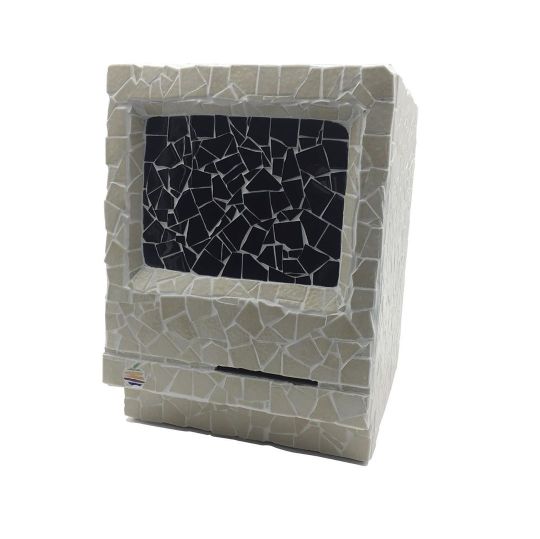
Le Série sur l’#Obsolescenceculturelle ! Le #MacintoshClassic SE/30 ! . Le Macintosh #SE/30 fut l'ordinateur le plus rapide de la famille Macintosh Classic. Il embarquait un processeur #Motorola 68030 ! @Apple #Mac #Apple #mosaique #mosaic #artmoderne #art #dailyart #instaart #artsy #pixel #pixelart #artcontemporain https://www.instagram.com/p/B5aCOsqA3sH/?igshid=8pp5c1ntdi8t
#obsolescenceculturelle#macintoshclassic#se#motorola#mac#apple#mosaique#mosaic#artmoderne#art#dailyart#instaart#artsy#pixel#pixelart#artcontemporain
2 notes
·
View notes
Text
Logic Planning

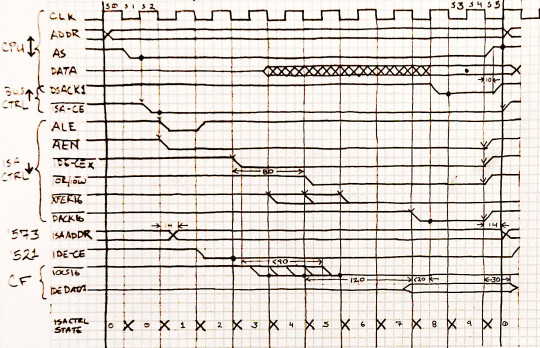
I'm working on adding IDE support to my Wrap030-ATX project.
This subsystem is a little complicated, because the CPLD I used for my bus controller didn't have enough I/O pins available to support it. As a result, the logic involves state machines in two different CPLDs working together, plus some additional discrete logic.
To figure out what the timing would look like, I first needed to identify which output signals were necessary for controlling IDE, and all of the input signals that would be used to generate those output signals, as well as the circuits these signals passed through. Instead of working with the complete computer schematic, it was helpful to draw out just the portions that are relevant to this subsystem roughly in input-to-output left-to-right order.
Once I had all of the relevant signals identified and a clear map of their paths through the system, I was able to draw up a timing diagram which follows each signal though time and through the schematic. This shows me when I need to assert specific outputs relative to the state of the various inputs and the system clock, in order to meet setup time requirements for the next stage of the subsystem.
The next step in the process is to plan a finite state machine to handle those signal transitions. Working through the timing diagram, I've determined that the ISA & IDE state machine will need to be clocked on the falling edge of the system clock. I've divided the timing diagram into states starting at each falling edge of the clock.
#wrap030 atx#wrap030#motorola#mc68030#motorola 68k#motorola 68030#homebrew#homebrew computer#retro computing
27 notes
·
View notes
Photo
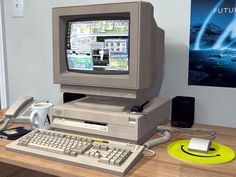
Amiga 3000 built on the success of A2000 but was entirely reworked and rethought as a high-end workstation. It used the new Motorola 32-bit 68030 CPU, 68882 math co-processor, and 32-bit system memory. A3000 marked the apex of classy design and outstanding build quality. https://ift.tt/2MNo6Pt
5 notes
·
View notes
Photo
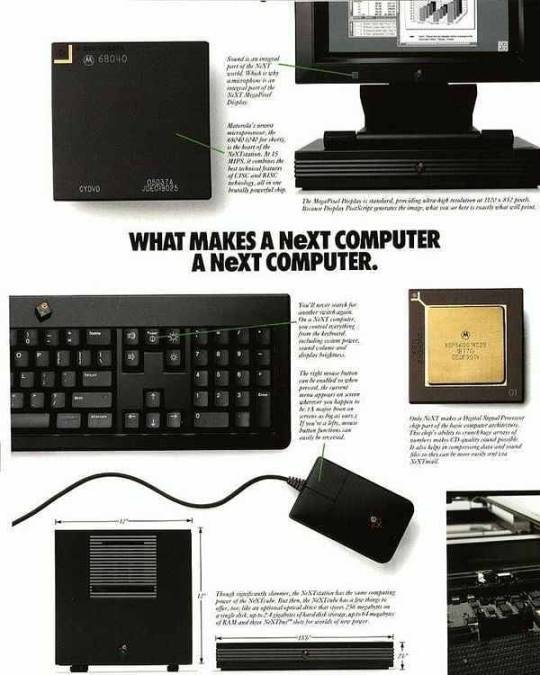
Evening everyone yesterday was a day off as was my birthday it was a blast today has been just as busy only one Trivia Time post tonight but it's worth a read so let's press on D.Y.K what happened on 12th October?. . On October 12th 1988 Steve Jobs Introduced NeXT Computer, Davies Symphony Hall in San Francisco, California. Steve Jobs shows off the NeXT Computer featuring the Motorola 68030 microprocessor at 25 MHz. The computer introduces several new features including optical storage disk, voice recognition, and object-oriented languages. The system came with the NeXT STep operating system and cost $6,500. . NeXT computer sold around 50,000 units. The NeXTSTEP Operating System was highly influential. It was the basis of Mac OS X. Apple acquired NeXT on Decemeber 20th, 1996 for $429 million in cash. Steve Jobs became interim CEO of Apple and the rest was history. . Steve Jobs almost didn’t come back after he was fired from Apple. He ended up not only founding NeXT, but also helped with Pixar. It does beg the question: Would we have an iPhone, iPad if Jobs wouldn’t have come back? Same question if he wasn’t brought back as CEO of Apple? Would it have been the NeXTPhone and NeXTPad?. . . . #TerrierByteIT #Wifeidge #computerhistory #computer #technology #history #computerscience #tech #computerhistorymuseum #computers #retro #vintage #retrotech #trivia #oldtechnology #techhistory #technologyhistory #computinghistory #oldcomputer #oldschool #informationtechnology #thisdayinhistory #internethistory #historyoftechnology #retrocomputer #oldtech #museum #vintagecomputer https://www.instagram.com/p/Bo2W4aAFN5H/?utm_source=ig_tumblr_share&igshid=1lci5ep0wqvki
#terrierbyteit#wifeidge#computerhistory#computer#technology#history#computerscience#tech#computerhistorymuseum#computers#retro#vintage#retrotech#trivia#oldtechnology#techhistory#technologyhistory#computinghistory#oldcomputer#oldschool#informationtechnology#thisdayinhistory#internethistory#historyoftechnology#retrocomputer#oldtech#museum#vintagecomputer
1 note
·
View note
Photo
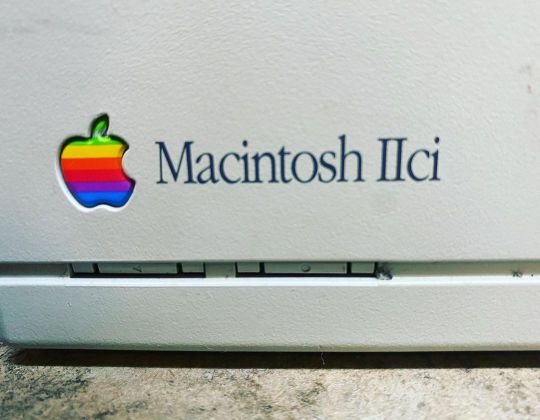
Well it’s not going to win any beauty pageants but the #MacIntosh IIci deserves a little love for being the long-lived business workhorse of the Macintosh line. Manufactured by #Apple Computers from 1989 to 1993 and retailing for a substantial $8,798 USD ($18,793 today) the #IIci was powered by the #Motorola 68030 processor, 40-80 MB #HDD and 1-4 MB (up to 128 MB) of RAM. The IIci #ROM also has an interesting #easteregg where if you set the date to September 20, 1989 (it’s release date) and hold down the Command+Option+C+I keys during boot time an image of the development team will be displayed! To find out more about our services please visit www.computation.ca, contact us at [email protected] or give us a call at 416-913-3443. #computation #toronto #computationrecycling #electronicsrecycling #computerrecycling #ewasterecycling #computerrepair #laptoprepair #applecomputer #macintoshIIci #classicapple #classicmac #retroapple #retromac #retrocomputer #retrotech #vintagecomputer #vintagemac #vintageapple #dontdespairwerepair (at Computation Ltd.) https://www.instagram.com/p/CKj1wEZBP2i/?igshid=bmc35zmptpaa
#macintosh#apple#iici#motorola#hdd#rom#easteregg#computation#toronto#computationrecycling#electronicsrecycling#computerrecycling#ewasterecycling#computerrepair#laptoprepair#applecomputer#macintoshiici#classicapple#classicmac#retroapple#retromac#retrocomputer#retrotech#vintagecomputer#vintagemac#vintageapple#dontdespairwerepair
0 notes
Text
Os 7 For Mac Download

Os 7 For Mac Download Cnet
Download Tomcat 7 For Mac Os
Mac OS 7 was a major change from the earlier System Software, introducing integrated multitasking, a revamped desktop, networking, and transitioning the name from 'Macintosh System Software' To 'MacOS'. It was followed by by MacOS 8.x.
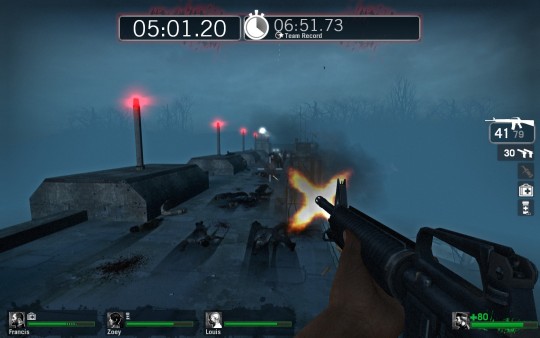
Python 2.7.10 - May 23, 2015. Download Mac OS X 32-bit i386/PPC installer; Download Mac OS X 64-bit/32-bit installer; Python 3.4.3 - Feb. Download Mac OS X 32-bit i386/PPC installer; Download Mac OS X 64-bit/32-bit installer; Python 2.7.9 - Dec. Download Mac OS X 32-bit i386/PPC installer; Download Mac OS X 64-bit/32-bit. Global Nav Open Menu Global Nav Close Menu; Apple; Shopping Bag +.
Running Mac OS 7.x requires a Motorola 68000 based Macintosh, a supported model of Power PC based Macintosh (7.1 or later) or one of the following emulators:
Mini vMac - Runs MacOS 1.1-7.5.5, emulates a black and white Motorola 68K based Mac Plus
Basilisk II - Runs MacOS 7.x-8.1, emulates later color Motorola 68k based Macs.
Os 7 For Mac Download Cnet
SheepShaver - Runs MacOS 7.5.2-9.0.4, emulates a Power PC based Macintosh.
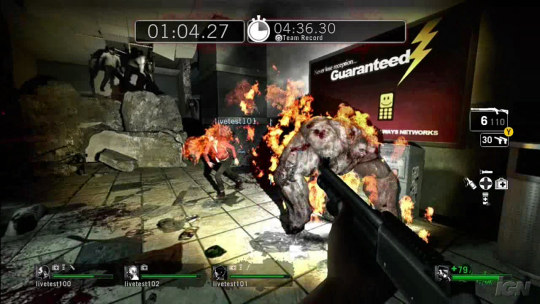

Screenshots
PreviousNext
Release notes
An interim catchup release in the wake of Windows 95, bundling some extra desk accessories, more hardware support, and new APIs such as the modernized Open Transport.
Installation instructions
Note: Some of these CD images are actually hard disk volumes. You can mount those in an emulator, or some older CD burning programs know how to write them as a CD/ISO.
Download Tomcat 7 For Mac Os
7.5.5 is the last supported version on Mac Plus, XL, Mac II, IIx, LC, IIcx, and SE/30, or anything with less than 68030 and 32-bit clean ROM.

0 notes
Text
This Old Mac Episode 8
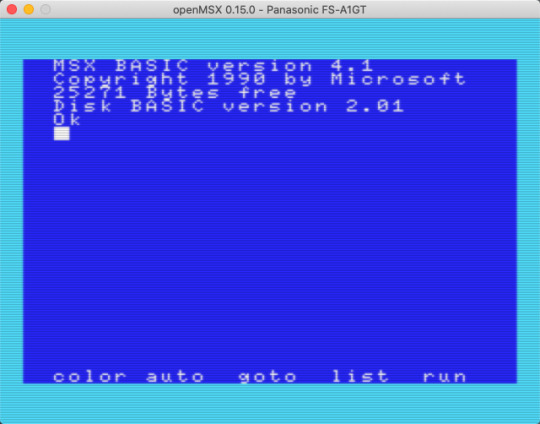
Hello people, welcome to the continuing saga of my foray into the world of Macintosh stuff. Well I must admit for main time recently I have been working with this i7 Hackintosh. The Mac Pro I admit I have not really used much as I currently don't have any projects regarding it.
So lately I have been playing with emulation. I have been working with two emulators in particular.
Both emulators have been primarily Japanese machines. The first one I have been looking at is OpenMSX. Obviously the MSX was designed between a conglomerate of companies including Panasonic, JVC, Sony, Hitachi and many more to try and create a central standard of home computers.
All had similar components and Basic provided by Microsoft. However for all the had a standardised base. It never really caught on. The concept of a universal base was a good idea but sadly it just didn't gain traction.
The main idea they did try and develop each standard moved a bit further. There was MSX, MSX 2, MSX 2+ and finally MSX Turbo R. So they really did try and get the machine over.
Anyway enough history and onto the emulator. OpenMSX can emulate all the above standards, the idea was each update was backwards compatible. OpenMSX allows you to set which machine you want to emulate. Obviously you need the system roms but they are widely available.
OpenMSX does come with a bios in the form of CBIOS which is a freeware bios replacement which means you can get most games and apps running. However I have been using the Goldstar A1GT bios which is a MSX Turbo R machine so I have the maximum compatibility.
Now MSX had various add-ons such as additional drives and sound chips. OpenMSX can have these added by selecting extensions providing you have the rom. So the amount of options is pretty high including hard drives and more.
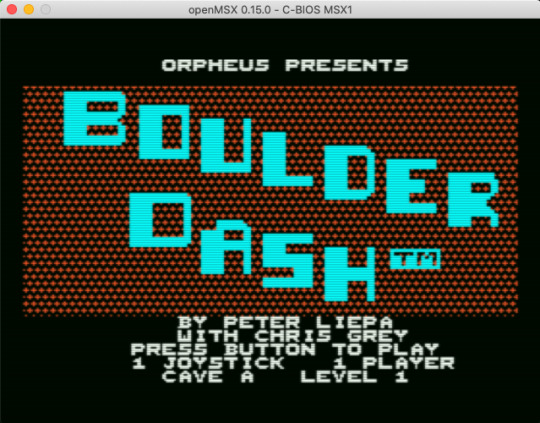
I admit MSX games are not reasonably good but I had an issue when I tried Boulder Dash on the A1GT so I used the CBIOS MSX 1 bios and all was fine.
One thing I will say is Boulder Dash on the MSX seems to run slightly faster than every other version I have played but it is possible to play if a bit twitchy.
OpenMSX is very comprehensive for its coverage but can be a bit awkward to get setup. If you have never used an MSX emulator it can be not straightforward to get working. The CBIOS is default so games can be played but if you want a different machine. In emulator it's easy to select but if you don't have it set up can be a bit of a headache to set up.
However once setup OpenMSX is a more than capable emulator.
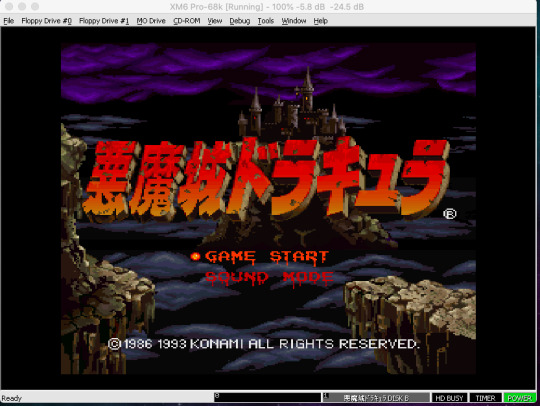
The second emulator I have been using is XM6 Pro 68K which is an emulator of the Sharp X68000.
The Sharp X68000 was only released in Japan. The initial machine was released in 1987 which had a 10Mhz Motorola 68000 CPU. It went through a many iterations and the final machine was in 1993 which had a 25 MHz Motorola 68030, with 4MB or RAM and an 80 GB SCSI hard drive.
The Sharp X68000 while popular in Japan never got out its home territory. Many games were written for the Sharp X68000 series and most are obviously in Japanese but certain games were in English.
Being a Japanese machine a lot of the games were Manga inspired with scantily clad young girls everywhere. However the Sharp X68000 had some very good arcade conversions. I wish I knew how to read Japanese so I could appreciate the games more as many are visual novel style so they have a lot of text.
However I spent a lot of time playing the excellent Akumajou Dracula aka Castlevania. The game is amazing and seems to be Rondo of Blood. The comparison to the PC Engine version is obvious and it has multiple paths just like the PC Engine has but it does have differences.
Now I have discussed the machine and the games. I now have to admit the XM6 Pro 68K emulator is a Windows version. I did try to run native Mac versions of Sharp X68000 emulators but I had issues.
The first emulator was called XM6i which I could get to open but i could not get it to play any games. The entire menu system was in Japanese so I had no idea what I had to do to get it started. So I couldn't use it.
I then tried to run RetroArch, which is a multi machine emulation system where you have to install various emulation cores.One of the cores is PX6a which apparently runs Sharp X68000 games. However every time I tried to run the machine regardless of the game I chose, it would just crash out.
So I had to try a different method. I had to run XM6 using CrossOver from Codeweavers. Crossover is a version of Wine for the Mac and the Codeweavers do contribute tot he actual Wine project as well as CrossOver.
Initially I could get the emulator running which it does by creating a Windows instance in a container they call a bottle but could not figure once the bottle was created how to run it again.
After a few attempts I discovered you could get a shortcut to the program in the bottle by running the emulator and there is an option to create a launcher for program ran.
So now I have XM6 Pro 68K running with with an icon on my dock. The Sharp X68000 is a very interesting machine but sadly due to not many of the games having translations many of them I can't get to appreciate.
Well I think that's enough for this episode so until next time... Take care.
1 note
·
View note
Photo
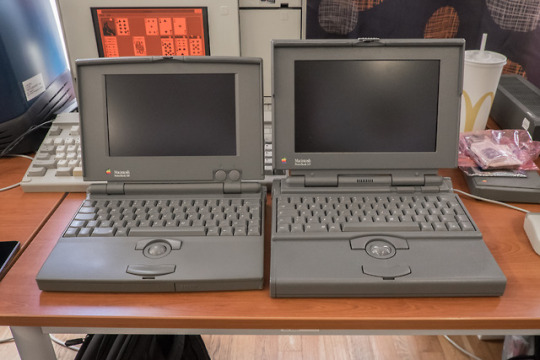

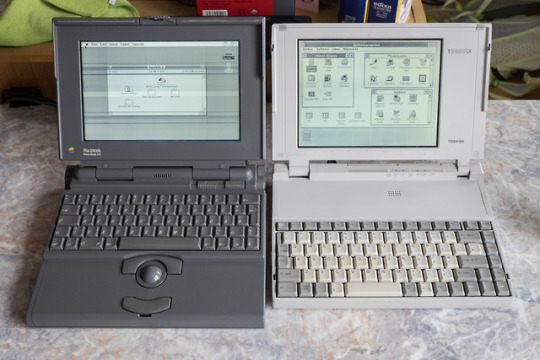

Early Apple Macintosh PowerBooks
PowerBook 100 has a special place in my heart. I had one back in the 1990s and I loved its big trackball, comfortable keyboard and proper palmrest area – features that were not present in typical PC laptops. Other early PowerBooks were not as small and light as the PowerBook 100, but they shared many design decisions with it. I perfectly understand people who bought and used these computers when they were new. On the other side, I cannot agree with those who see early PowerBooks as universally superior machines to PC notebooks. That’s just not true.
From time to time, I see nonsense statements like that PowerBooks were the first laptops with stereo sound, optical drives, docking stations or other features. Not sure at the moment, but I think that you can find some of these statements even on Wikipedia. However, all of these features were previously available in PC laptops.
In fact, the generations of early PowerBooks that came after the first generation were not considered very innovative back then. Just a few examples:
- Support for gray-scale video modes on internal screens was added at the end of 1992. Until that, it was possible to run only programs that were written to work with the black and white mode. All VGA-equipped PC laptops supported gray scale and could also translate colors into levels of grey in hardware (no OS or program support was required).
- Unlike with PC laptops, there was no support for features like color LCD screens, PCMCIA expansion cards and microprocessors with built-in power management capabilities in 1992.
- There was no graphics acceleration in Apple’s video circuits which resulted in significantly slower screen redraw. This started to be a problem when Apple offered PowerBooks with color screens where the graphics core had to process far more data. The first color PowerBooks with competitively fast graphics chips were available after Apple started to use generic PCI solutions from the PC world (mostly Chips & Technologies, later ATI).
- Many of the PowerBook graphics chips didn’t support more than 256 colors on external screens even in 1994. Lower-end machines didn’t even have a video output for an external screen.
- The first color TFT PowerBook – 180c – was released in August, 1993 – almost a year after major PC brands released their first TFT portables. The PowerBook 180c was equipped with a small 8.4-inch 640x480 screen when PC laptops often used 9.5-inch screens and there were some with even 10.5-inch screens (like the famous IBM ThinkPad 700C – December, 1992). That was not the only issue – it lasted only about an hour on one charge because (unlike PC laptops) it didn’t have a 3.3V CPU, advanced power management features and NiMH batteries.
- Heat and power consumption was so big issue with Motorola 68040 that Apple had to release 040-based PowerBooks with a version of the CPU that didn’t have a math coprocessor. Thus, programs that used it heavily were twice as fast when running on the previous generation of high-end 030-based PowerBooks. 486DX-based PC laptops could run the same code four times as fast.
The machines on the photos:
(1) Apple PowerBook 100 (1991), 16-MHz 68000, 4MB RAM, 20MB HDD
(2) Toshiba T2200SX (1991), 20-MHz 386SX, 4MB RAM, 60MB HDD
(3) Apple PowerBook 145 (1993), 25-MHz 68030, 8MB RAM, 80MB HDD
90 notes
·
View notes
Text
Today in Apple history: The first great color PowerBook arrives
June 7, 1993: Apple debuts the PowerBook 180c, a solid upgrade that brings a world of dazzling colors to the company’s laptop line.
The 180c’s big improvement over the grayscale PowerBook 180, which launched the previous October, is its active-matrix, 256-color screen. It’s something of a novelty for laptops in the early 1990s.
PowerBook 180c: A great portable Mac
The PowerBook 180c was one of the high-end models in Apple’s enormously successful PowerBook 100 series. Launched in late 1991, the PowerBook quickly became a staple of Apple’s product line. It also proved a well-deserved commercial and critical smash.
The PowerBook 180c wasn’t the first color PowerBook (it was beaten to that title by the PowerBook 165c), but it was the first to offer high-quality color.
Great color screen. Battery life? Not so hot.
Photo: Apple
The PowerBook 165c sported an 8.4-inch, passive-matrix color display, which could appear dim if not viewed head-on under ideal conditions. The 180c, meanwhile, boasted a backlit active-matrix display that presented high-quality color from whichever angle you looked at it.
In short, this was the first great color display on a Mac laptop.
It also featured a slightly higher resolution than the PowerBook 165c, being the first PowerBook to natively run at 640×480 pixels, rather than the 165c’s 640×400.
The PowerBook 180c also boasted impressive specs. It came with a zippy 33 MHz Motorola 68030 CPU and 6882 math coprocessor. It packed 4MB of RAM (expandable to 14MB using an additional RAM card). Despite its chunky case design, the laptop proved comfortable to use. This model remained in great demand for its entire lifespan.
Unlike today’s MacBooks, the PowerBook featured a bunch of ports. You got a plug for Apple Desktop Bus services, two RS-422 serial ports, a SCSI port, microphone and speaker jacks — even a bay for a modem. In addition, users could output to external monitors using a 256-color video connector.
…with a couple of downsides
Unfortunately, the machine suffered from two downsides. First, the display was slightly smaller than the 10-inch display of the original PowerBook 180c — and actually a fraction smaller than the 9-inch PowerBook 165c. Most users agreed that the smaller size was a fair tradeoff for high-quality color, but it still meant the computer’s display wasn’t superior to its predecessor in every single way.
The bigger problem? Pathetic battery life.
Running both a 33 MHz CPU and color graphics limited how long you could use the PowerBook on a single charge. According to Apple’s own figures, it ran between one and two hours — but reasonably intense usage could cut this down to less than an hour.
The PowerBook 180c cost $3,719 for the basic model, while the fully kitted-out version cost $4,079. That’s between $6,293 and $6,902 in today’s prices. Apple ultimately discontinued the laptop in March 1994.
Did you use this PowerBook model? Leave your comments below.
Source
The post Today in Apple history: The first great color PowerBook arrives appeared first on abangtech.
from abangtech https://abangtech.com/today-in-apple-history-the-first-great-color-powerbook-arrives/
0 notes

